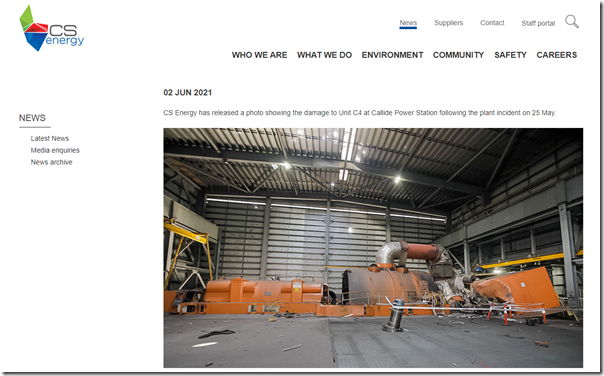Images are doing the rounds on social media, so I thought I’d firstly jump to the Eskom website to confirm the incident on Sunday night just past. This media release was published on Monday 9th August:
Medupi Unit 4 generator failure
Monday, 09 August 2021: Eskom wishes to inform the public that Unit 4 of Medupi Power Station experienced an explosion on the Unit 4 generator at approximately 22h50 on 08 August. The incident is suspected to have resulted in Unit 5 tripping.
No injuries have been reported and all employees and contractors have been accounted for. Emergency services attended to seven colleagues requiring treatment for shock. Eskom will continue to provide support to the employees who might have been affected by the incident through its Employee Assistance Programme (EAP).
Unit 4 was on a short-term outage (since 06 August) when the incident occurred, and all work on the unit was suspended with immediate effect. This included the suspension of all permits to work on the plant until further notice. The area was secured and once it has been cleared by the Fire Chief and resident engineers; inspections and assessments will begin to determine the cause of the incident and extent of the damage caused.
Preparation for the return to service of Medupi Unit 5 is currently in progress.
Investigations are underway into the cause of the incident and Eskom will update the public on developments, as well as to what extent will this unfortunate incident impact the national electricity grid.
… and this was followed by this ‘first update’:
First Update: Medupi Unit 4 generator failure
Monday, 09 August 2021: Eskom wishes to inform the public that Unit 4, which was on a short-term outage (since 06 August 2021) of Medupi Power Station experienced an explosion on the Unit 4 generator at approximately 22h50 on 08 August 2021. This explosion has resulted in extensive damage to the generator.
The incident occurred during the activity to displace hydrogen with carbon dioxide and air respectively, for the purposes of finding an external leak. Fortunately no injuries were sustained by personnel who were on site during the unfortunate incidents.
Following the power station preliminary investigation, it appears that while performing this activity air was introduced into the generator at a point where hydrogen was still present in the generator at sufficient quantities to create an explosive mixture, which ignited and resulted in the explosion. It also appears that there was a deviation from the procedure for carrying out this activity.
As such Eskom has undertaken to place those employees who were responsible to manage and execute this work under precautionary suspension pending the conclusion of the Major Event Investigation.
Investigations are underway into the cause of the incident and Eskom will update the public on developments, as well as to what extent this unfortunate incident will impact the national electricity grid.
(A) Commentary on social media
This thread on Twitter by Chris Yelland provides some interesting details:
Particularly at the bottom of the thread, readers here might be interested to the link to this article in Power Engineering describing how ‘Hydrogen cools well, but safety is crucial’. Given Eskom have already noted that hydrogen explosion is the probable cause (in the ‘first update’ above) it seems useful to link people through to that article.
No doubt there will be coverage elsewhere as well.
(B) Similarities to Callide B4?
There clearly is at least one similarity between what seems to have happened with the Callide C4 Catastrophe … and that is that there’s a huge amount of damage (compare the images above with the photo that’s done the rounds of Callide C4 (such as in the AFR on 2nd June 2021) – and was first published by CS Energy here on 2nd June 2021:
However readers should use caution in drawing other links – for instance, there was speculation after the Callide C4 incident that hydrogen explosion was involved.
Dr Sean Brady was appointed to lead an independent investigation on 11th June 2021 – and (as far as I know) nothing has been concluded, yet, as to what caused the explosion at Callide C4. It might be hydrogen-related … but it also could be due to a number of other factors …




Medupi: If air was admitted whilst there was still hydrogen in the alternator then it was a pressure vessel and thus an internal explosion has occurred. Hence the explosive damage to the alternator.
Callide: The unit was in service, thus it would have contained pure hydrogen. Failure of the seal oil system would have allowed an external explosion when the escaping hydrogen mixed with air. Hence the alternator in the photo is intact but shows signs of burning at both ends.
Medupi: The Damage is confined to the Generator and surroundings. The end covers are blown OFF and Excitation Gear is damaged but since the unit was OFF LINE and stationery there appears to be little damage to the LP Turbines and the structure of the Turbogenerator set is largely intact. The generator is probably fixable because it was not running. There is quite a bit of Building damage, more than at Callide C4, mainly because the Generator is approximately twice the size.
In comparison with Callide C4 where it is clear that the shaft is destroyed and the turbines severely damaged seems to indicate that the Callide unit had a catastrophic Turbine failure followed by a hydrogen explosion after the Generator Casing was ruptured.
The AEMO Incident report on Callide C4 makes interesting reading, particularly Section 3, page 10, in summary:
– prior to failure Callide C4 was at 278 MW
– 13:34 it ceased generating but did NOT disconnect
– 13:40 AEMO were advised by Callide of a possible turbine fire
– 13:44 Callide C4 absorbing 50 MW and 300 MVars (275Kv voltage healthy)
– 14:06 Multiple 275Kv CB’s opened causing large blackouts
https://aemo.com.au/-/media/files/electricity/nem/market_notices_and_events/power_system_incident_reports/2021/preliminary-report–trip-of-multiple-generators-and-lines-in-queensland-and-associated-underfrequenc.pdf
Was there a hydrogen explosion at Callide at all? Or did the GE of the LP turbine destroy itself during the motoring, possibly without lube oil? The damage done is not what one would expect from a hydrogen fire
Probably a lube oil fire and hydrogen explosion due to leaks following turbine damage. From the damage at each end of the LP cylinder and holes in the roof, I would have said an it was an overspeed causing the turbine last stage blades to fail but there don’t seem to be holes in the LP casing. Maybe there was a loss of lube oil while the generator remained synchronized as you have suggested and this caused the turbine to want to stop while the generator wanted to keep it going and this led to the shaft rupturing?
The published information on the motoring shows firstly that the machine did not overspeed and secondly, there was major resistance to the turning at grid speed. It is very unlikely it could have motored if there had been a hydrogen explosion. And it seems to have motored until the line was disconnected at the substation.
There is other information around on primary and secondary causes but nothing formal.
All that has been published so far hints at operation as an induction motor. Unofficial speculation hints at loss of steam, excitation, lubricating oil, and power to protection systems occuring simultaneously.
Windage loss will heat the turbine, circulating currents heat the generator, and loss of oil destroys the bearings.